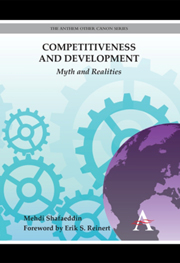Book contents
- Frontmatter
- Contents
- List of Tables, Figures and Boxes
- Foreword
- Preface
- Acknowledgements
- List of Abbreviations
- 1 Introduction: Framework of Analysis
- 2 Context and Conditions of International Competition
- 3 Alternative Theories of Competitiveness
- 4 Firm Strategy and New Industrial Organization
- 5 External Economies: Organization of Interfirm Relations
- 6 Reputation and Trust: A Firm's Relations with Stakeholders and Others
- 7 Innovation and Upgrading
- 8 Government Policies
- 9 The Experiences of China and Mexico
- 10 Summary and Concluding Remarks
- Appendices
- Bibliography
- Index
5 - External Economies: Organization of Interfirm Relations
Published online by Cambridge University Press: 05 February 2013
- Frontmatter
- Contents
- List of Tables, Figures and Boxes
- Foreword
- Preface
- Acknowledgements
- List of Abbreviations
- 1 Introduction: Framework of Analysis
- 2 Context and Conditions of International Competition
- 3 Alternative Theories of Competitiveness
- 4 Firm Strategy and New Industrial Organization
- 5 External Economies: Organization of Interfirm Relations
- 6 Reputation and Trust: A Firm's Relations with Stakeholders and Others
- 7 Innovation and Upgrading
- 8 Government Policies
- 9 The Experiences of China and Mexico
- 10 Summary and Concluding Remarks
- Appendices
- Bibliography
- Index
Summary
[E]xecutives must extend their thinking beyond what goes on inside their own organizations and within their own industries. Strategy must also address what goes outside.
(Porter 1998, 86–7)Introduction
External economies contribute to the competitive advantage of a firm. The sources of external economies may be at the industrial level, national level or international level. At the industry level the previous existence of other industrial firms and their experience will provide newcomers with external economies; these firms may be suppliers or engaged in distribution or other downstream activities. The large size of the market is the most important source of external economies because it not only allows for the specialization and division of labour at the industry level, but is also necessary for the materialization of internal economies. External economies may also arise from agglomeration: collective efficiency through clustering, industrial districts and production sharing and, further, from learning and experience at the industry level. At the national level, the existence of developed infrastructure, efficient institutions and availability of back-up services is beneficial to a firm through their dampening influence on production and distribution costs. Thus government policies which aim at provision of these facilities contribute to external economies indirectly. Further, a favourable national reputation (e.g. the Japanese reputation in electronics) allows a firm to engage in mass production and thus increase returns. Ethier (1982) argues that the source of external economies can also be international: in the age of globalization economies resulting from agglomeration, production sharing among various countries, etc.
- Type
- Chapter
- Information
- Competitiveness and DevelopmentMyth and Realities, pp. 107 - 134Publisher: Anthem PressPrint publication year: 2012



